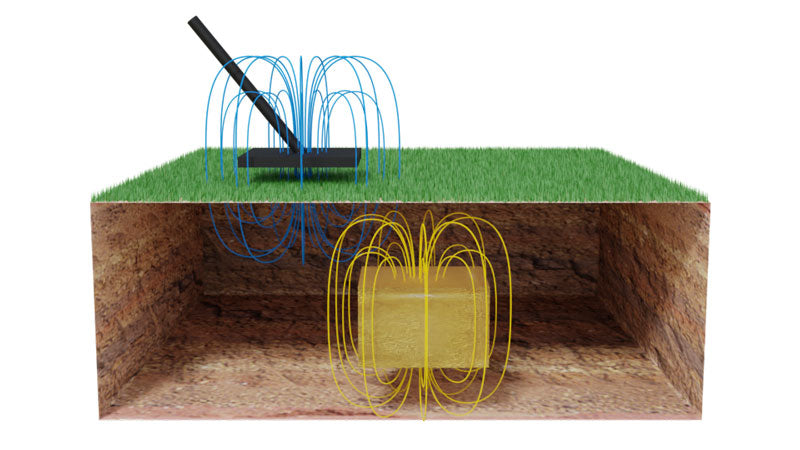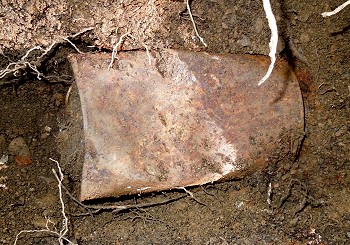Who wants to find GOLD, should not ignore IRON either
Everybody knows the opposites of big and small, light and dark, good and evil. The one cannot exist without the other. But what does this have to do with gold and iron? This is exactly what this treasure hunter blog is about. First of all, let's ask ourselves why:
Why do you only search for gold
and don't pay attention to further materials?
Possible answers could be:
- I only want to find gold because that is the most valuable and I can get rich with it.
- I don't want to waste my time by digging up useless junk.
- Precious metals like gold are the real treasures. What should I do with ferrous scrap or old pottery?
- Gold brings the most cash.
These all seem to be reasonable arguments for digging only in those places where the metal detector can discriminate a corresponding gold signal. However, this tutorial will explain in more detail why you should still dig if iron signals are detected.
After reading this tutorial, you will certainly think quite differently about ferrous metals or similar metal objects. Promised!
Focusing on Gold Only will Prevent You from Maximum Success
Quite often our customers, who are usually treasure hunters from all over the world, request a metal detector that only detects gold. All other metals are regarded as worthless and are not of interest for gold hunters. You may agree with that and have set your own detector to gold mode in order to filter out all other materials.
In fact, this can quickly lead to missing many valuable treasures, even though valuable riches lie beneath your feet. Now consider: If you had to bury gold yourself, would you just put the gold in the ground, or would you somehow put the precious goods into a container? The world's greatest gold finds didn't just lie buried in the ground, but the gold was carefully enclosed in boxes, cans and similar containers. What if these were made of metals such as iron, aluminum, bronze, copper or steel?
Even boxes made of wood consist to a large extent of metal fittings such as hinges, locks and ornaments, and consequently are also perceived as a metallic signal with the metal detector. If there is gold in the wooden treasure chest, but you do not excavate it because of the iron signature, you will also leave the gold behind! The next treasure hunter who passes over the secret hiding place may see things differently and, despite the iron signature, will reach for the shovel and retrieve the valuable treasure.
Trap Finds Distract Treasure Hunters
Very often riches and treasure hoards were buried with trap finds, i.e. grave goods of lower value were deposited above the actual finds to keep potential tomb raiders away from the real treasure. Suppose you come across such an object and leave it because you assume it is not worth digging - in any case, your metal detector will show you anything but gold. In that case, you will never know whether further down - in deeper layers of the soil - valuable treasure finds are waiting to be discovered.

Therefore, don't just dig up the first find, but scan the same spot again with the detector to mke sure there are no more treasure finds hidden deeper. Of course, this means a much greater time commitment, but the prospect of a fabulous gold find should be worth it.
Why Gold in Metal Boxes Cannot Always be Discriminated as Gold
Let's explore the technical and scientific background of metal discrimination: Why are gold coins, gold jewelry and other gold objects enclosed in metallic containers made of iron, aluminum or steel not always and reliably recognized as gold?
All metal detectors use electromagnetic fields to detect the presence of metallic objects.

Passive detectors measure either the magnetic fields of the buried objects themselves or the changes in the earth's magnetic field caused by such a buried treasure object. For passive measurements, it is therefore extremely advantageous if the gold objects have been packed in iron boxes, tins or canisters before being buried.

Active detectors generate a time-varying magnetic field to determine the presence and conductance of an underground metallic object. The strength of the received signal and the time shift with respect to the transmitted signal depend on various factors:
- Conductivity of the buried materials/metals
- Type of soil
- Frequency of the metal detector
- Size of the buried objects
- Depth at which the treasures are buried
Depending on the type of technology used, it is possible to determine the conductance of the metallic treasure object or how a buried object in the area of the search coil alters the earth's natural magnetic field.
Based on these measured values, conclusions can be drawn about the type of metallic objects. However, the factors mentioned above make it very difficult to distinguish several different objects from each other. Different object sizes and different depths can additionally lead to misleading results. If the gold was deposited in an iron box, then the signal of the surrounding box overlays the gold contained in it and cannot necessarily be identified as such.
Sensational Gold Treasures Hidden in Containers
The following gold treasures were hidden in containers and would never have been found if the treasure hunter had ignored them due to the lack of a gold signal.
Hoxne Hoard: Gold and Silver Coins in a Wooden Treasure Chest
In November 1992, British treasure hunter Eric Lawes made an unusual discovery in a field near Hoxne, in Suffolk (England). While searching for a lost hammer, his metal detector struck. But instead of the tool, scattered coins and pieces of jewelry came to light. The finder immediately informed the archaeologists in charge, who then unearthed countless further precious finds.
In addition to Roman gold and silver coins from the 4th and 5th centuries, as well as jewelry and utensils, the archaeologists also found remnants of hinges and locks. These metal fittings came from the wooden chests in which the valuable goods had been stowed before being buried. The treasure find from Hoxne is still the largest late Roman hoard find in the British Isles and consists of more than 15,000 individual pieces, which the interested visitor can admire in the British Museum.
The total value of the find was 1.75 million Pounds (about € 3.8 million).

Photograph by Mike Peel (www.mikepeel.net)., CC BY-SA 4.0, via Wikimedia Commons
Gold Bars in a Tank
In 2017, British entrepreneur Nick Mead purchased a replica of a Soviet T-54 tank at the auction platform eBay. While restoring and cleaning the vehicle, he and his business partner discovered five large gold bars worth about € 3 million. It is believed that the tank was involved in the 1990 invasion of Kuwait and Iraqi soldiers stole the gold and hid it in the tank.
If the tank had been buried or sunk somewhere, a treasure hunter would have received a massive iron signal with his metal detector. If he had then ignored it, the gold would have remained hidden as well.
It was not uncommon for disused tanks to be dumped in lakes, ponds or swamps. Again and again militaria collectors come across the remains of these military vehicles. Do you have a rough idea of what the tank crews have hidden there?

Weldon Kennedy from London, UK, CC BY 2.0, via Wikimedia Commons
Saddle Ridge Hoard: Gold Coins in Cans
In Northern California in 2013, a couple found several rusty containers buried on their rural Gold Country residence. The property was in close proximity to the site of the famous 1849 Gold Rush. What made the find so sensational was not the tin cans, of course, but their gleaming contents: more than 1400 gold coins dating from 1847 to 1894.

While the nominal value of the hoard of coins was just under $28,000, its collector value was estimated at over $10 million.
Known as the "Saddle Ridge Hoard", the treasure find is billed as the largest U.S. find of buried coins. Whether the amazing coin find has any connection with the gold rush, however, could not be clarified.

Kagin's Inc., CC BY-SA 3.0, via Wikimedia Commons
Again, this example shows that those who do not disdain old rusty things may be rewarded. All the coins had been carefully packed in old tin cans and then buried in the ground. Any treasure hunter would have missed the gold again, if he or she only digs gold signals.

Forrest Fenn's Bronze Treasure Chest
In 2010, millionaire art dealer and author Forrest Fenn hid a treasure chest: a bronze box filled with gold pieces, rare coins, precious relics, expensive jewelry, and gemstones. The only clues he was willing to give were hidden in a poem written by himself.
Even equipped with a metal detector, adventurers first had to find the place where the chest was buried. Since the valuables were packed in a box made of bronze, metal detectorists had to look for bronze values.
On June 6, 2020, Forrest Fenn finally announced that his treasure had been found. Read more about the treasure, who found it and where.


